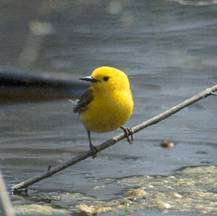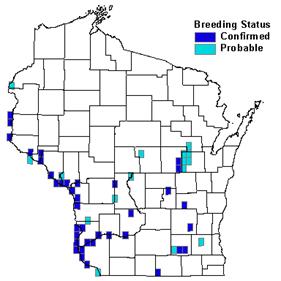

Status/Protection
- Global Rank: G5 Key to global and state ranks
- State Rank: S3B
- WBCI Priority: SGCN, State Special Concern
Population Information
Federal BBS information can be obtained at http://www.mbr-pwrc.usgs.gov/bbs/bbs.html by clicking on Trend Estimates and selecting the species in question. All estimates are for 1966-2005.
*Note: There are important deficiencies with these data. These results may be compromised by small sample size, low relative abundance on survey route, imprecise trends, and/or missing data. Caution should be used when evaluating this trend.
- Federal Breeding Bird Survey: significant decline
- Federal Breeding Bird Survey (WI): N/A
- Federal Breeding Bird Survey (BCR 23): non-significant increase*
- Federal Breeding Bird Survey (BCR 12): N/A
- WSO Checklist Project: stable (1983-2007)
Life History
- Breeding Range: Southeastern Wisconsin south to eastern Texas east to the Atlantic Coast; largely absent from the Appalachian Mountains (Petit 1999).
- Breeding Habitat: Bottomland Hardwood.
- Nest: Cavity, 0.6 - 9.75 meters above ground.
- Nesting Dates: Eggs: late May to mid-June (Robbins 1991).
- Foraging: Bark and foliage glean (Ehrlich et al. 1988).
- Migrant Status: Neotropical migrant.
- Habitat use during Migration: Not well understood, but may include plantations, scrub, and bottomland forests (Petit 1999).
- Arrival Dates: Late April to late May (Robbins 1991).
- Departure Dates: Present until early September (Robbins 1991).
- Winter Range: Most common from extreme southern Mexico south to Colombia and Venezuela; uncommon to rare on Caribbean islands.
- Winter Habitat: Closely associated with mangrove, but also in various stream corridors and pastures (Petit 1999).
Habitat Selection
The Prothonotary Warbler breeds in moist bottomland forests that are seasonally flooded or permanent wetlands. Along the Mississippi River in Wisconsin, Prothonotary Warbler breeding habitat contains a variety of overstory trees, including eastern cottonwood, black willow, silver maple, green ash, and river birch. Dominant understory plants include woodbine, wood-nettle, jewelweed, violet, and poison ivy (Flaspohler 1996). Essential habitat characteristics include slow-moving, medium to large rivers (Flaspohler 2006), dead trees with suitable cavities for nests, flat terrain, and sparse understory (Petit 1999). Prothonotary Warblers also prefer large forest tracts. Sallabanks et al. (2000) documented a positive correlation between Prothonotary Warbler abundance and swamp forest patch size.
The Prothonotary Warbler is the only eastern warbler that nests in tree cavities. It uses either natural or woodpecker-excavated cavities in dead snags or limbs of live trees, as well as nest boxes (Petit 1999). Trees with nest cavities average 15 to 20 cm in diameter at breast height (Kahl et al. 1985, Blem and Blem 1991). Average nest height is 2 m above the ground or water surface. Nests usually are placed over water, either slow-moving or still (Petit 1999).
Habitat Availability
Wisconsin is on the northern edge of the Prothonotary Warbler’s breeding range (Petit 1999). It is a fairly common migrant and summer resident along the Mississippi and lower St. Croix rivers and an uncommon migrant and summer resident along the lower Wisconsin River (Robbins 1991) and Wolf River. Bottomland hardwood and other floodplain forests have fared better than many of Wisconsin’s native habitats due to the difficulty of converting them to other land uses. Nevertheless, only 8% of presettlement floodplain forest remains in moderate to high quality condition (Mossman 1988). Invasive plant species, particularly reed canary grass, may impede regeneration in floodplain forests. Development pressures also continue to threaten remaining floodplain forest tracts (WDNR 2005).
Population Concerns
Breeding Bird Survey (BBS) data suggest a significant population decline range-wide for the Prothonotary Warbler. However, its status is not well known in Wisconsin where it is not adequately monitored by BBS methodology (Sauer et al. 2005). It is a regular but localized breeder in the southern half of the state. During the six-year period (1995-2000) of the Wisconsin Breeding Bird Atlas, observers documented breeding activity in 5% and confirmed nesting in 3% of the surveyed quads (Flaspohler 2006).
The Prothonotary Warbler’s habitat specificity makes it highly vulnerable to loss of forested wetlands on the breeding and wintering grounds (Petit 1999). Stream channeling, flood control, and logging practices can reduce habitat suitability and availability (Petit 1999). Brown-headed Cowbird parasitism also is a concern. Brood parasitism rates are higher for the Prothonotary Warbler than for any other cavity-nesting species (Friedmann 1963, Friedmann et al. 1977) with rates reaching 26% in Wisconsin (Goffin 1994 cited in Matteson 1994, Flaspohler 1996). Parasitized nests suffer high mortality and low fledging rates (Petit 1991). Finally, the House Wren is considered a major competitor, causing approximately 33% of mortality to eggs and young in Michigan (Walkinshaw 1941).
Recommended Management
Management efforts for Prothonotary Warblers should focus on maintaining large blocks of floodplain forests (WDNR 2005), particularly along the Mississippi, Rock, Wisconsin, lower Wolf, and Yellow rivers. Management practices that retain trees with nest cavities and/or retain snags and stumps in floodplain forests would likely benefit this species. Nest box programs in fragmented or degraded riparian areas may provide alternative nesting substrates. Conservation and management strategies for this species should be focused in the following Wisconsin ecological landscapes: Central Lake Michigan Coastal, Central Sand Plains, Southeast Glacial Plains, Western Coulee and Ridges, and Western Prairie (WDNR 2005).
Research Needs
Targeted surveys in appropriate habitats are needed to better understand the Prothonotary Warbler’s population status in Wisconsin. A better understanding of minimum area requirements and the health of floodplain forests in Wisconsin would help future management efforts here. Studies investigating success rates of natural cavity nests in habitats of different quality are warranted. More information is needed on the impacts of mangrove forest loss on the wintering grounds (Petit 1999).
Information Sources
- Audubon WatchList: http://audubon2.org/webapp/watchlist/viewSpecies.jsp?id=165
- Cornell Lab of Ornithology Birdhouse Network: http://www.birds.cornell.edu/birdhouse/bios/sp_accts/prwa
- Cornell Lab of Ornithology Birds of Forested Landscapes: http://birds.cornell.edu/bfl/speciesaccts/prowar.html
- North American Breeding Bird Survey: http://www.mbr-pwrc.usgs.gov/bbs/bbs.html
- Patuxent Bird Identification Center: http://www.mbr-pwrc.usgs.gov/id/framlst/i6370id.html
- Temple S.A., J.R. Cary, and R. Rolley. 1997. Wisconsin Birds: A Seasonal and Geographical Guide. Wisconsin Society of Ornithology and Wisconsin Department of Natural Resources, Madison, WI.
- Wisconsin Breeding Bird Atlas: http://www.uwgb.edu/birds/wbba/
References
- Blem, C.R. and L.B. Blem. 1991. Nest-box selection by Prothonotary Warblers. J. Field Ornithol. 62: 299-307.
- Ehrlich, P.R., D.S. Dobkin, and D. Wheye. 1988. The birders handbook: a field guide to the natural history of North American birds. Simon & Schuster, Inc. New York.
- Faaborg, J., and W. Arendt. 1984. Population sizes and philopatry of winter resident warblers in Puerto Rico. J. Field Ornithol. 5: 376-378.
- Flaspohler, D.J. 1996. Nesting success of the Prothonotary Warbler in the upper Mississippi River bottomlands. Wilson Bull. 108: 457-466.
- Flaspohler, D.J. 2006. Prothonotary Warbler. In Atlas of the Breeding Birds of Wisconsin. (N.J. Cutright, B.R. Harriman, and R.W. Howe, eds.) The Wisconsin Society for Ornithology, Inc. 602pp.
- Friedmann, H. 1963. Host relations of the parasitic cowbirds. U.S. Natl. Mus. Bull. 233.
- Friedmann, H., L.F. Kiff, and S.I. Rothstein. 1977. A further contribution to knowledge of the host relations of the parasitic cowbirds. Smithson. Contr. Zool. 235.
- Kahl, R.B., T.S. Baskett, J.A. Ellis, and J.N. Burroughs. 1985. Characteristics of summer habitats of selected nongame birds in Missouri. Research Bulletin 1056. Missouri Agricultural Experiment Station, Columbia, MO.
- Lefebvre, G., B. Poulin, and R. McNeil. 1992. Abundance, feeding behavior, and body condition of Nearctic warblers wintering in Venezuelan mangroves. Wilson Bull. 104: 400-412.
- Lefebvre, G., B. Poulin, and R. McNeil. 1994. Spatial and social behaviour of Nearctic warblers wintering in Venezuelan mangroves. Can. J. Zool. 72: 757-764.
- Lopez Ornat, A., and R. Greenberg. 1990. Sexual segregation by habitat in migratory warblers in Quintana Roo, Mexico. Auk 107:539-543.
- Matteson, S.W. 1994. Conservation of endangered, threatened and nongame birds in Wisconsin 1 July 1993 to 30 June 1994. Passenger Pigeon 56: 247-261.
- Mills, E.D., and D.T. Rogers. 1992. Ratios of Neotropical migrants and Neotropical resident birds in winter in a citrus plantation in central Belize. J. Field. Ornithol. 63: 109-116.
- Moore, F.R. 1990. Prothonotary Warblers cross the Gulf of Mexico together. J. Field Ornithol. 61: 285-287.
- Mossman, M.J. 1988. Birds of southern Wisconsin floodplain forests. Passenger Pigeon 50: 321-337.
- Petit, L.J. 1991. Adaptive tolerance of cowbird parasitism by Prothonotary Warblers: a consequence of nest-site limitation? Anim. Behav. 41: 425-432.
- Petit, L.J. 1999. Prothonotary Warbler. The Birds of North America, No. 408 (A. Poole and F. Gill, eds.). The Birds of North America, Inc., Philadelphia, PA.
- Robbins, S. D., Jr. 1991. Wisconsin birdlife: Population and distribution past and present. Madison, WI: Univ. Wisconsin Press.
- Russell, S. M. 1980. Distribution and abundance of North American migrants in lowlands of northern Colombia. Pp. 249-252 In: A. Keast, and E. S. Morton [eds.]. Migrant birds in the Neotropics: Ecology, behavior, distribution, and conservation. Smithson. Inst. Press, Washington, D.C.
- Sallabanks, R., J.R. Walters, and J.A. Collazo. 2000. Breeding bird abundance in bottomland hardwood forests: habitat, edge, and patch size effects. Condor 102: 748-758.
- Sauer, J.R., J.E. Hines, and J. Fallon. 2005. The North American Breeding Bird Survey, Results and Analysis 1966 - 2005. Version 6.2.2006. USGS Patuxent Wildlife Research Center, Laurel, MD.
- Walkinshaw, L. H. 1941. The Prothonotary Warbler, a comparison of nesting conditions in Tennessee and Michigan. Wilson Bull. 53: 3-21.
- Wisconsin Department of Natural Resources (WDNR). 2005. Wisconsin’s Strategy for Wildlife Species of Greatest Conservation Need. Madison, WI.
Contact Information
- Compiler: Tom Klubertanz, tklubert@uwc.edu
- Editors: Kim Kreitinger, K.Kreitinger@gmail.com
